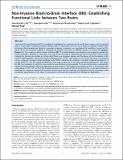| dc.contributor.author | Yoo, Seung-Schik | |
| dc.contributor.author | Kim, Hyungmin | |
| dc.contributor.author | Filandrianos, Emmanuel | |
| dc.contributor.author | Taghados, Seyed Javid | |
| dc.contributor.author | Park, Shinsuk | |
| dc.date.accessioned | 2013-11-05T22:13:35Z | |
| dc.date.issued | 2013 | |
| dc.identifier.citation | Yoo, Seung-Schik, Hyungmin Kim, Emmanuel Filandrianos, Seyed Javid Taghados, and Shinsuk Park. 2013. Non-invasive brain-to-brain interface (bbi): establishing functional links between two brains. PLoS ONE 8(4): e60410. | en_US |
| dc.identifier.issn | 1932-6203 | en_US |
| dc.identifier.uri | http://nrs.harvard.edu/urn-3:HUL.InstRepos:11294950 | |
| dc.description.abstract | Transcranial focused ultrasound (FUS) is capable of modulating the neural activity of specific brain regions, with a potential role as a non-invasive computer-to-brain interface (CBI). In conjunction with the use of brain-to-computer interface (BCI) techniques that translate brain function to generate computer commands, we investigated the feasibility of using the FUS-based CBI to non-invasively establish a functional link between the brains of different species (i.e. human and Sprague-Dawley rat), thus creating a brain-to-brain interface (BBI). The implementation was aimed to non-invasively translate the human volunteer’s intention to stimulate a rat’s brain motor area that is responsible for the tail movement. The volunteer initiated the intention by looking at a strobe light flicker on a computer display, and the degree of synchronization in the electroencephalographic steady-state-visual-evoked-potentials (SSVEP) with respect to the strobe frequency was analyzed using a computer. Increased signal amplitude in the SSVEP, indicating the volunteer’s intention, triggered the delivery of a burst-mode FUS (350 kHz ultrasound frequency, tone burst duration of 0.5 ms, pulse repetition frequency of 1 kHz, given for 300 msec duration) to excite the motor area of an anesthetized rat transcranially. The successful excitation subsequently elicited the tail movement, which was detected by a motion sensor. The interface was achieved at 94.0±3.0% accuracy, with a time delay of 1.59±1.07 sec from the thought-initiation to the creation of the tail movement. Our results demonstrate the feasibility of a computer-mediated BBI that links central neural functions between two biological entities, which may confer unexplored opportunities in the study of neuroscience with potential implications for therapeutic applications. | en_US |
| dc.language.iso | en_US | en_US |
| dc.publisher | Public Library of Science | en_US |
| dc.relation.isversionof | doi:10.1371/journal.pone.0060410 | en_US |
| dc.relation.hasversion | http://www.ncbi.nlm.nih.gov/pmc/articles/PMC3616031/pdf/ | en_US |
| dash.license | LAA | |
| dc.subject | Biology | en_US |
| dc.subject | Biochemistry | en_US |
| dc.subject | Neurochemistry | en_US |
| dc.subject | Neuromodulation | en_US |
| dc.subject | Biotechnology | en_US |
| dc.subject | Computational Biology | en_US |
| dc.subject | Computational Neuroscience | en_US |
| dc.subject | Model Organisms | en_US |
| dc.subject | Animal Models | en_US |
| dc.subject | Rat | en_US |
| dc.subject | Neuroscience | en_US |
| dc.subject | Neurophysiology | en_US |
| dc.subject | Engineering | en_US |
| dc.subject | Bioengineering | en_US |
| dc.subject | Human Factors Engineering | en_US |
| dc.subject | Man Computer Interface | en_US |
| dc.title | Non-Invasive Brain-to-Brain Interface (BBI): Establishing Functional Links between Two Brains | en_US |
| dc.type | Journal Article | en_US |
| dc.description.version | Version of Record | en_US |
| dc.relation.journal | PLoS ONE | en_US |
| dash.depositing.author | Yoo, Seung-Schik | |
| dc.date.available | 2013-11-05T22:13:35Z | |
| dc.identifier.doi | 10.1371/journal.pone.0060410 | * |
| dash.contributor.affiliated | Yoo, Seung-Schik | |


